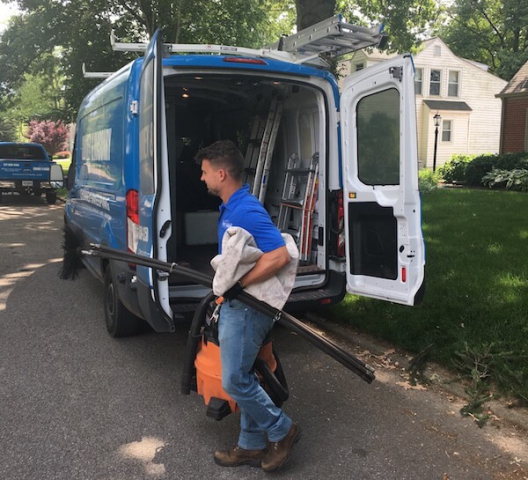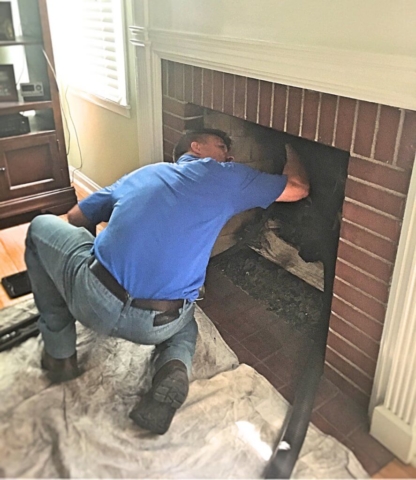Chimney Sweep Services in Indianapolis
An annual chimney sweep isn’t just a good practice — it can keep your family safe. Since your chimney is attached to the outdoors, dust, soot and small creatures can settle in your chimney liner, damper, firebox and smoke chamber. If this buildup is not taken care of, it can reduce fireplace efficiency and even start a fire.
Without proper care, your home could be at risk of a catastrophe. Choosing Brick + Ember Outfitters for chimney cleaning services is the solution to keeping your space well-insulated and comfortable during the colder months.
[Schedule Your Chimney Sweep Now]
When to Call a Chimney Cleaning Company
Regular chimney sweeps are extremely important for performance and safety. The general rule of thumb is that you should have your chimney cleaned at least once a year. This annual service can prevent large fires in your home, which has the potential to save lives.
Sweeps are especially important if you have a wood-burning fireplace. Wood creates a residue called creosote. This flammable residue ends up lining the walls of flue systems. When your fireplace burns hot enough, the creosote can relight and cause a flue fire. These fires can go undetected because they burn at the top of your chimney flue system.
An annual sweep can also save you money. When your system is blocked, your fireplace doesn’t heat your home efficiently, which can lead to spending more on expensive heating alternatives.
Although your annual sweep is vital, there are other times of the year when a sweep may be required. If you are having performance issues with your chimney, fireplace or heating system, it may be time to get a sweep. Even if you’ve had a sweep in the past year, variable weather conditions can cause excessive dirt to build up in your home.
You should also get a sweep after you purchase a home. Although you may be diligent in keeping up your fireplace, the previous homeowners may not have been as kind. A quick cleaning as soon as you move in will ensure you can enjoy your fireplace for the next year to come.
Our Process Starts With an Inspection
If you feel there may be a problem with your chimney, know our certified technicians will give you a thorough inspection to lead you in the right direction. There are three different levels of chimney inspections, but all include inspections of the same vital elements, including rain caps, brick and mortar, flue liners and fireplace blowers:
- Level one inspection: The most common chimney inspection is level one. This inspection is completed on a chimney that is well-maintained, with sweepings year after year.
- Level two inspections: These are recommended after a change is made to your chimney or if you have just bought your home. This inspection ensures the chimney is working properly and that there is no visual damage.
- Level three inspections: Experts finish a level three inspection when a chimney is visibly damaged. This level of inspection requires intense skills to find issues hidden on the inside and outside of your chimney. The service can help detect damage from flue-fires.
A Trusted Source for Chimney Maintenance in Indianapolis
At Brick + Ember Outfitters, we ensure all of our technicians are highly trained to provide the best customer service. All of our technicians are certified by the Chimney Safety Institute of America (CSIA). They’ve worked on all types of chimneys and fireplaces, so you can rest assured that you are in good hands.
When finding the right chimney sweep, professionalism is key to a job well done. We ensure all of our technicians carry ID, so you know who is coming into your home. When you request an appointment, all of our technicians arrive in a branded car, so you can build trust from the start. Our technicians also listen to your needs. When we meet with you, we aren’t selling you a sales pitch. Instead, we learn your sweeping needs so we can provide the highest quality service.
Brick + Ember Outfitters is driven by three value-added initiatives: building equity, restoring beauty and growing peace of mind. Investing in the safety and functionality of your fireplace and chimney goes a long way.
Advantages of Hiring a Professional Chimney Sweep
The experts at Brick + Ember Outfitters want to see you happy with your chimney installation for years to come. Our incredible attention to detail and years in the industry allow us to catch problems while cleaning before they impact your fireplace’s well-being. The advantages below highlight the value of our chimney sweep services in Indianapolis:
- Consistent heating: A chimney that has undergone cleaning services should have improved airflow. Verify warm air stays inside and smoke exits at the top of the assembly.
- Extended life span: Clean chimney installations work without trouble and experience fewer buildups that cause deterioration. Get the most from your chimney by having Brick + Ember Outfitters visit routinely.
- Fewer repairs: Having one of our professionals clean your residential chimney is a form of preventive maintenance. Request a follow up appointment for us to complete a repair before it gets out of hand.
- Safe indoor environment: Reduce the chances of harmful gases, including carbon monoxide from moving inside.
Request an Appointment With Our Experts
Unlike competitors, Brick + Ember Outfitters asks what you need and want as a homeowner in the greater Indianapolis area. We look at your home as if it were our own and work with you to make budget-conscious decisions for your fireplace and chimney. Our team is the obvious choice for professional chimney sweep services, as we’ve been working hard in the industry to make a difference across our local community since 2011.
Request an appointment with one of our CSIA-certified technicians by reaching out to us today!
Chimney Sweep Frequently Asked Questions
If you are new to a home with a chimney or are curious about our process for professional chimney sweep services, Brick + Ember Outfitters put together some frequently asked questions to provide additional insight. Look through the details below to hear more about what to expect from our chimney cleaning assistance.
1. Why do chimneys need to be cleaned?
Chimneys, especially wood-burning ones, create creosote and soot buildup. This buildup is hazardous and reduces the efficiency of your chimney.
Creosote is a thick tar-like material that’s brown or black. When combustible materials (like wood) are burned, creosote deposits on the flue lining of your chimney. All three forms of creosote are flammable, but the one that is most flammable and difficult to clean is a shiny, slick texture. Creosote is a huge risk for chimney fires. The built-up creosote is highly flammable, any embers that float up could cause the creosote to catch fire and start a chimney fire.
Additionally, a chimney caked in creosote will not be as efficient. The creosote limits the airflow and can trap heat in the chimney. This makes your fireplace less efficient, and could also result in harmful gases reentering your home. A chimney without good airflow can lead to carbon monoxide poisoning.
Wood smoke produces creosote, with unseasoned firewood producing the most. Seasoned hardwood burns clean, creating much less creosote than unseasoned firewood, but all wood will cause creosote that eventually builds up in your chimney.
Soot is another reason to clean chimneys. It’s black, flay and powdery. The substance is made from amorphous carbon and is produced upon incomplete combustion of coal, wood and other organic materials. The soot particles adhere to the chimney lining. If moisture mixes with soot or creosote, it creates an acidic substance that damages the chimney lining.
2. Can I clean my own chimney?
Many people try, but unfortunately, home remedies cannot compare to a professional chimney sweep. Common chimney-cleaning home remedies that fall short are outlined below:
- Using a pine tree like a “cleaning brush” and running it down your chimney
- Starting a chimney fire to burn off the creosote and soot (VERY dangerous and can lead to an entire house fire and severe chimney damage)
- Attempting to soften the creosote deposit by burning potato peels in your fireplace
- Adding salt to your logs as they burn in the fireplace
3. What tools does a professional chimney sweep use?
Chimney cleaning procedures have advanced dramatically in recent years. Modern chimney sweeps have an arsenal of tools at their disposal. Primary tools for a chimney sweep are:
- Brushes: There are a few types of brushes chimney sweeps will use. One is the long wire brush. This brush is sturdy enough to remove creosote, but can also navigate tight spaces. For creosote that’s in a glazed form, a stiff flat wire-bristle brush is often used. For small spaces and crevices, chimney sweeps use hand brushes.
- Vacuums: All of the soot and creosote that’s cleaned from a chimney must go somewhere. Chimney sweeps use powerful industrial vacuum cleaners to collect the soot and creosote before they enter your home.
- Chemical cleaners: Sometimes, brushes struggle to remove all of the built-up deposits on a chimney flue lining. For very stubborn and difficult creosote, chimney sweeps use chemical cleaning agents.
4. When is the best time to have a chimney professionally cleaned?
Professional chimney cleaning services can be completed at any time, but it is wise to schedule a visit with our team toward the end of summer or early fall before you depend on the installation for indoor heat. Having us clean your chimney prior to winter is an effective way to verify your installation is free of creosote, soot and buildups that make it difficult for the chimney to work correctly.
Scheduling service prior to winter also allows you to beat the rush when other homeowners in the Indianapolis area realize they forgot this much-needed service.
GET IN TOUCH
Are you ready to fix your chimney, masonry, or fireplace issues? Fill out the form below to request an appointment. One of our Outfitters will get back with you shortly.


